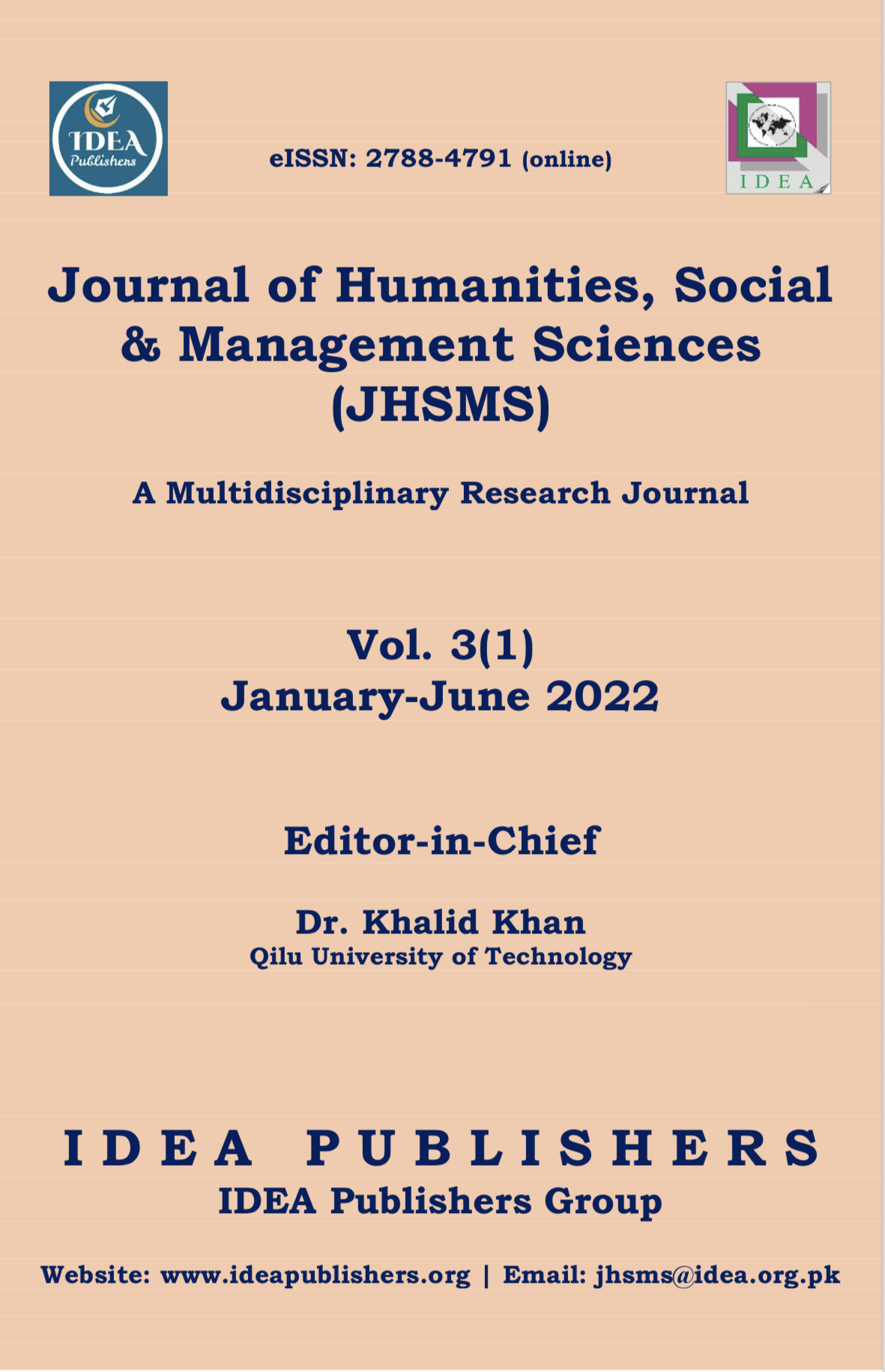Sinophobia in the semiotic representation of Covid-19 in English language newspapers
DOI:
https://doi.org/10.47264/idea.jhsms/3.1.5Keywords:
Sinophobia, Covid-19, Semiotics, English Language Newspapers, Discourse, fearAbstract
This study examines use of semiotic resources, deployed by selected English language newspapers to describe a discourse of Sinophobia in the first wave of Covid-19. It explores how was the discourse of Sinophobia (anti-Chinese sentiments) expressed by highly circulated English language newspapers in the world? The data was based on 10 editorial articles of four English language newspapers: “The New York Times, The Guardian, The Tribune, and The Japan Times”. In addition, 30 participants’ perceptions about the semiotic choices used by these newspapers were studied to support the findings from selected editorials. Public comments were taken on the notion that they should talk about China and the role of Chinese people in spreading Covid-19. The data was interpreted through thematic analysis by codifying the emerging discursive themes. The findings reveal that semiotic resources deployed by the selected English language newspapers created a discourse of Sinophobia as the data laid great stress on the emergence of virus in the City of Wuhan, China. Moreover, the use of semiotic resources by the English language newspapers is replicated by the participants, as the language of the newspapers and participants on these semiotic resources surface positive self-claim and negative out-group. They divide between them and us, have and have not, eventually widened the language of fear, panic, and hatred.
References
Albader, F. (2020). Coronavirus and the resurgence of Sinophobia. Tsinghua China Law Review, 12(2), 289. http://www.tsinghuachinalawreview.org/articles/1202_Albader.htm
Berger, P. L., & Luckmann, T. (1966). The social construction of reality: A treatise in the sociology of knowledge. Anchor.
Clarke, V., & Braun, V. (2014). Thematic analysis. In Encyclopedia of critical psychology (pp. 1947-1952). Springer. https://doi.org/10.1007/978-1-4614-5583-7_311 DOI: https://doi.org/10.1007/978-1-4614-5583-7_311
Cap, P. (2016). The language of fear: Communicating threat in public discourse. Palgrave Macmillan Springer.
Cohen, S. (2013). States of denial: Knowing about atrocities and suffering. John Wiley & Sons.
Corradi, J. E., Fagen, P. W., Garretón, M. A., & Merino, M. A. G. (Eds.). (1992). Fear at the edge: State terror and resistance in Latin America. University of California. DOI: https://doi.org/10.1525/9780520912205
Gralinski, L. E., & Menachery, V. D. (2020). Return of the Coronavirus: 2019-nCoV. Viruses, 12(2), 135. https://doi.org/10.3390/v12020135 DOI: https://doi.org/10.3390/v12020135
Hua, J., & Shaw, R. (2020). Corona virus (Covid-19) “infodemic” and emerging issues through a data lens: The case of China. International Journal of Environmental Research and Public Health, 17(7), 2309. https://doi.org/10.1016/j.envpol.2017.12.006 DOI: https://doi.org/10.3390/ijerph17072309
Kress, G. R., & Van Leeuwen, T. (1996). Reading images: The grammar of visual design. Psychology.
Kress, G. (2009). Multimodality: A social semiotic approach to contemporary communication. Routledge.
Mahr, D. (2020). The cultural construction of the ‘Bizzare’. Disentangling Sinophobic Language in media and science during the COVID-19 Epidemic (#WitnessingCorona). https://www.medizinethnologie.net/the-cultural-construction-of-the-bizzare/
Marko, D. (2013). Fear control in media discourse. Southeastern Europe, 37(2), 200-219, https://doi.org/10.1163/18763332-03702005 DOI: https://doi.org/10.1163/18763332-03702005
Rafi, M. S. (2020). Language of COVID-19: Discourse of fear and Sinophobia. Social Sciences & Humanities Open. http://dx.doi.org/10.2139/ssrn.3603922 DOI: https://doi.org/10.2139/ssrn.3603922
Roche, G. (2020). The epidemiology of Sinophobia. Made in China Journal. https://madeinchinajournal.com/2020/02/17/the-epidemiology-of-sinophobia/ DOI: https://doi.org/10.22459/MIC.05.01.2020.01
Saul, J. (2019). What is happening to our norms against racist speech? Aristotelian Society, 93(1), 1-23. https://doi.org/10.1093/arisup/akz001 DOI: https://doi.org/10.1093/arisup/akz001
Seay, L., & Dionne, K. Y. (2014, August 25). The long and ugly tradition of treating Africa as a dirty, diseased place. The Washington Post. https://www.washingtonpost.com/news/monkey-cage/wp/2014/08/25/othering-ebola-and-the-history-and-politics-of-pointing-at-immigrants-as-potential-disease-vectors/
Schild, L., Ling, C., Blackburn, J., Stringhini, G., Zhang, Y., & Zannettou, S. (2020). "Go eat a bat, chang!": An early look on the emergence of sinophobic behavior on web communities in the face of covid-19. arXiv preprint arXiv:2004.04046.
Silver, L., Devlin, K., & Huang, C. (2019). US views of China turn sharply negative amid trade tensions. Pew Research Center. https://www.pewresearch.org/global/wp-content/uploads/sites/2/2019/08/Pew-Research-Center_U.S.-Views-of-China-Report_2019-08-13.pdf
Van Dijk, T. A. (1991). Racism and the press. Routledge.
Van Dijk, T. A. (2009). Society and discourse: How social contexts influence text and talk. Cambridge University. DOI: https://doi.org/10.1017/CBO9780511575273
Van Dijk, T. A. (2014). Discourse and knowledge: A sociocognitive approach. New Cambridge University. DOI: https://doi.org/10.1017/CBO9781107775404
Yong, C. (2020). UK police release images of 4 men linked to COVID-19 racist attack on Singaporean student in London. The Straits Times Singapore. https://www.straitstimes.com/singapore/uk-police-release-images-of -4-men-linked-tocovid-19
Zhang, C. (2008). From Sinophilia to Sinophobia: China, history, and recognition. Colloquia Germanica, 41(2), 97-110. https://www.jstor.org/stable/23981714
Zhao, I. (2020). Coronavirus has sparked racist attacks on Asians in Australia. ABC News. https://www.abc.net.au/ news/2020-02 01/coronavirus-hassparked-racist-attacks-on-asian-australians/11918962
Zheng, Y., Goh, E., & Wen, J. (2020). The effects of misleading media reports about COVID-19 on Chinese tourists’ mental health: a perspective article. Anatolia, 31(2), 337-340. https://doi.org/10.1080/13032917.2020.1747208 DOI: https://doi.org/10.1080/13032917.2020.1747208
Downloads
Published
How to Cite
Issue
Section
License
Copyright (c) 2022 Shahzad Nabi

This work is licensed under a Creative Commons Attribution-NonCommercial 4.0 International License.
Please click here for details about the Licensing and Copyright policies of IDEA-PG.















